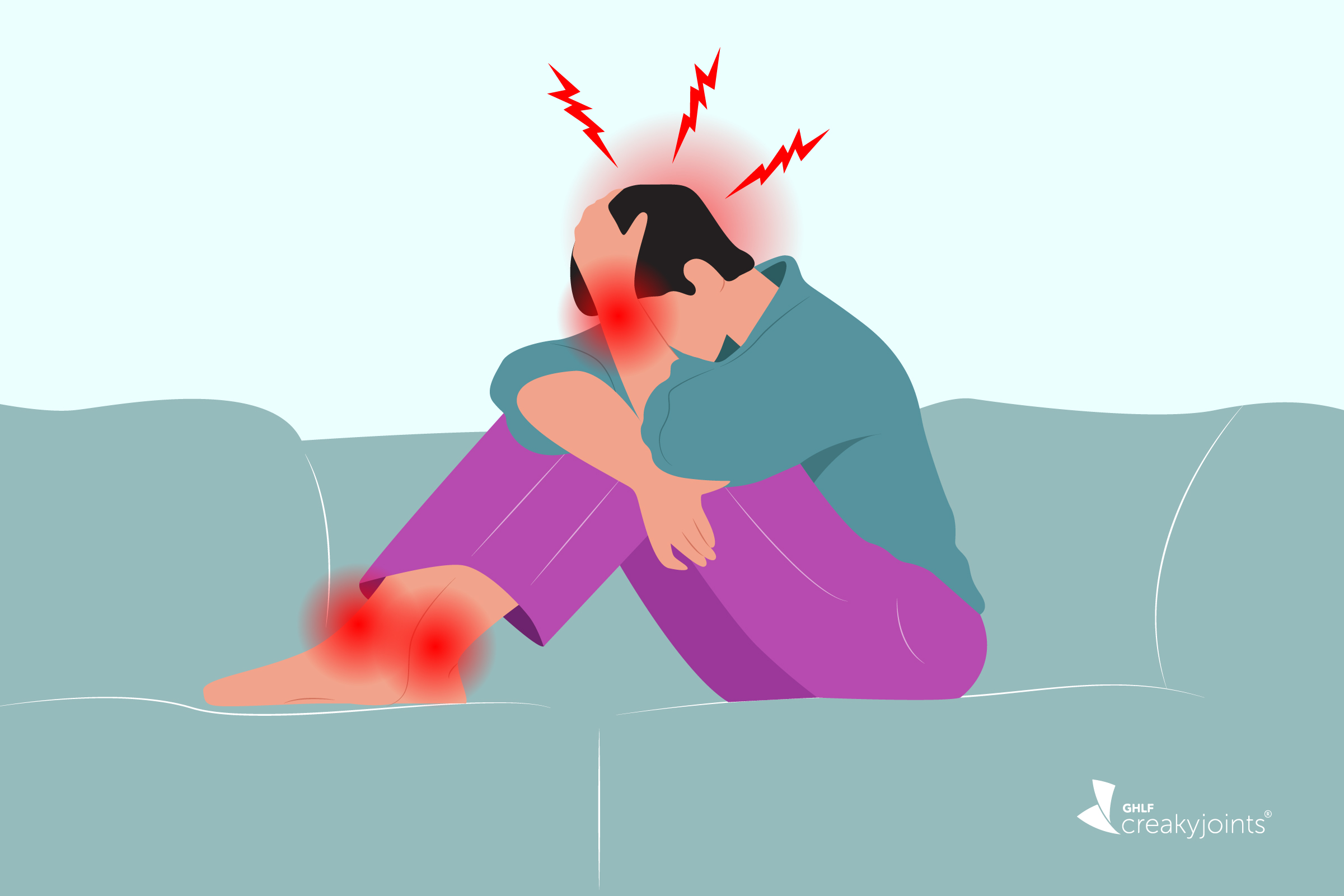The Up-End Migraine Project reveals key gaps in episodic migraine care, aiming to drive change and improve treatment options for patients through insights from both providers and patients.
“I’ve Been Prescribed an Injection for Migraine — What Should I Know?”
“I’ve Been Prescribed an Injection for Migraine — What Should I Know?”
Injectable CGRP inhibitors can be life-changing for many people with migraine. Find out about the benefits, side effects, and how they work to curb the frequency of attacks.
October 31, 2022
Karyn Repinski

Calcitonin gene-related peptide (CGRP) inhibitors are a class of medication that’s prescribed to prevent migraine attacks.
In contrast to other treatments used to prevent the neurological condition, which were usually developed for other reasons and borrowed as migraine treatments, CGRP inhibitors were developed based on the understanding of the chemistry of migraine and what occurs during a migraine attack.
The medications work by blocking the effect of CGRP. A small protein that’s involved in the transmission of pain, CGRP has been shown to play a big role in both episodic migraine, defined as having up to 14 headache days a month, and chronic migraine, characterized by 15 or more headache days a month.
For instance, according to Brad Torphy, MD, lead doctor for the Chicago Headache Center and Research Institute, there’s evidence that:
- Blood levels of CGRP are elevated during a migraine attack.
- People with migraine have higher CGRP levels between attacks than those without migraine normally have.
- CGRP levels are higher in people with chronic migraine than episodic migraine.
CGRP may even play a role in causing migraine attacks: When CGRP was injected via IV, most people with migraine got a migraine within four hours.
Adding insult to injury, CGRP may also worsen headache pain and make it last longer.
How Do Injectable CGRP Inhibitors Work?
Injectable CGRP inhibitors are monoclonal antibodies, a collection of identical proteins that have been engineered to target and block a single substance in the body — in this case, CGRP.
To understand how these new medications disrupt the CGRP process, Dr. Torphy uses a lock-and-key analogy. “CGRP is a substance we have all over our bodies, and — as is the case with most things our body produces — it binds to a receptor, like a key opening a lock, which leads to a reaction in the body,” he explains.
During a migraine attack, CGRP, a potent vasodilator, is released and binds to receptors in the trigeminal nerve, a large nerve in your head that sends sensations from your face to your brain, leading to pain.
Monoclonal antibodies work in one of two ways, “so CGRP can’t achieve its destiny to bind to receptors,” Dr. Torphy explains. One is by inactivating the receptor (aka “block the lock” ) or by binding to CGRP itself, to prevent the key from opening the lock.
The following drugs are approved for people with episodic migraine and chronic migraine with or without aura.
Aimovig, Ajovy, Emgality are given as self-administered monthly injections; Vypeti is administered by a healthcare provider as an IV infusion four times a year.
The Benefits of Preventative Injections
If you’re prescribed an injectable CGRP inhibitor it’s probably because first-line medications haven’t worked for you. The goal with these medications is to help with frequency, severity, and duration of migraine.
“Over half of patients taking these medications cut their headache days by 50 percent or more,” says Dr. Torphy, who notes that the numbers for each injectable CGRP inhibitor are quite similar. In 20 percent to 30 percent of cases, headache days are reduced by 70 percent or more.
To put that into perspective, for chronic migraine patients who have headache 15 or more days a month, the medication would reduce that to about seven to eight days a month — converting them from chronic migraine to episodic migraine.
When tallied up over the course of a year, that means they could be expected to have nearly three months without migraine, compared to the previous year when they had migraine, explained Stewart Tepper, MD, a professor neurology at the Geisel School of Medicine at Dartmouth and director of the Dartmouth Headache Center at the Dartmouth-Hitchcock Medical Center, in an interview with the American Migraine Foundation.
The upshot: “Everyone is different in terms of what they consider life-changing, but every day at least one patient says this is life-changing,” says Dr. Torphy. As a result, “it’s extremely gratifying to treat migraine these days, much more than used to be the case.”
This can be especially true in people for whom other preventive migraine medications proved ineffective. Injectable CGRP inhibitors are often used to treat migraine when other remedies fail, often with good success.
Other benefits include:
- The long half-life of the drugs. Because they’re strong and have a long duration of action, the injections only have to be administered monthly or quarterly — making it less likely to miss a dose. The continuous action also means that you don’t have to wait to have a migraine attack to take the medication, note researchers.
- A lack of drug interactions. Because they specifically target CGRP, there don’t seem to be any drug interactions with injectable monoclonal antibodies and other migraine treatments. So while injectable CGRP inhibitors cut the usage of migraine medication, when a migraine breaks through, people will still be able to take their acute treatments.
How Soon Do Injections Work?
In lucky people, the injections work, well, like a shot. “It started working almost immediately,” reports Michelle Tracy, 37, migraine advocate and author of The Migraine Warrior. “It was wild — I hadn’t been pain-free in ages.”
While there will be cases where people start to feel better within a day or a week, Dr. Torphy says they’re outliers. “These are not immediate-acting agents.” For people with chronic migraine, it usually takes one to three months to see improvement. For people with daily headaches, it can take eight to 12 months to see improvement — possibly because so much CGRP has been released that it takes time for the body to adapt.
“It’s a lot to ask for patients to stay on the medication for that long, but we’ve seen it time and again that patients have been on the meds for that long and then start to see improvement,” says Dr. Torphy.
What Are the Side Effects?
Not only do monoclonal antibodies tend to work better than other preventive medications, they offer another huge advantage: These medications have very few side effects, says Dr. Torphy. “They work better, and the icing on the cake is that they’re much better tolerated than the older medications — anti-seizure medicines, blood pressure medicines, and antidepressants — we would tend to use.”
In clinical trials, the most commonly reported adverse events were mild to moderate and occurred in a small fraction of people, including:
- Local injection site reactions
- Nausea
- Fatigue
- Constipation
Considering that CGRP is a very important molecule that’s found throughout the body, it’s not surprising that blocking it for long periods of time may lead to more — or more severe — side effects. “The clinical trials were three to six months, and with more experience, sometimes side effects will pop up,” says Dr. Torphy, who notes that some people have reported severe constipation, hair loss, nausea, muscle cramps, cardiac complaints, worsened migraine, and joint pain.
If you are experiencing side effects, speak with your doctor and decide whether or not to make a change, says Dr. Torphy. “There’s a lot of gaslighting in the medical community — ‘Oh, no, that’s not possible,’” he adds. “Doctors need to listen to patients.”
Now that the drugs have been used for several years, the long-term systemic effects are becoming better known. For instance, because CGRP plays a key role in widening your blood vessels, the medications’ action to tighten blood vessels may cause side effects that affect your blood pressure and heart health. Dr. Torphy recommends that patients taking these injectables undergo blood pressure monitoring, especially if they have risk factors for hypertension.
As for why people on injectable CGRP inhibitors may experience constipation, Dr. Torphy explains that there are receptors for CGRP in our gut that can be inactivated by the medication. “It’s thought this can slow down transit time in the gut, which can lead to constipation.” People who struggle with regular bowel movements should alert their provider, who may choose another monoclonal antibody to manage their migraine attacks.
Tips for Self-Injection
Because they’re “large-molecule” proteins, monoclonal antibodies are injected under the skin. Most of these treatments are administered with an auto-injector, a spring-loaded syringe that only requires you to hold it to your skin and press a button.
You may not see the needle (a plus for people with needle phobia), but it can still sting. “The majority of patients say it’s tolerable, but some find it really painful,” says Dr. Torphy.
To lessen the discomfort:
- Take the medication out of the refrigerator at least 30 minutes prior to injection. “Warming it up makes the medication less viscous, so it’s more easily injected,” Dr. Torphy explains. You can also use your body heat to warm it up in your hand; just don’t put it in the microwave or on the stove.
- Ice the injection area for a few minutes beforehand to help numb it.
- Inject it in the meatiest of the three injection sites — your thigh, stomach, or upper arm.
- Don’t hesitate. Sometimes the anticipation of the shot is worse than the shot itself.
- Ice after the injection to reduce pain and swelling.
If you can’t handle self-injections, talk to your health care provider about tips to ease your anxiety or alternatives that are right for you and your migraine.
Hear From More Experts and Patients Living with Migraine
Talking Head Pain is a podcast that confronts head pain, head on. Brought to you by the Global Healthy Living Foundation and hosted by migraine advocate Joe Coe, this show explores how people living with migraine, cluster headache, and other types of intense pain find ways to better manage their disease. Listen here.
Sources:
Bucklan, J, et al. “CGRP Antagonists for Decreasing Migraine Frequency: New Options, Long Overdue.” Cleveland Clinic Journal of Medicine. April 2020. doi: https://doi.org/10.3949/ccjm.87a.19048.
CGRP and More: Treating Trigeminal Nerve Dysfunction. Migraine.com. February 2022. https://migraine.com/clinical/cgrp-treating-trigeminal-nerve-dysfunction.
Interview with Brad Torphy, MD, lead doctor for the Chicago Headache Center and Research Institute.
Scuteri, D, et al. “New Trends in Migraine Pharmacology: Targeting Calcitonin Gene–Related Peptide (CGRP) With Monoclonal Antibodies.” Frontiers in Pharmacology. April 9, 2019. doi: https://doi.org/10.3389/fphar.2019.00363.
What to Know About the New Anti CGRP Treatment Options. American Migraine Foundation. May 2018. https://americanmigrainefoundation.org/resource-library/anti-cgrp-treatment-options/.
SUBSCRIBE TO GHLF
RELATED POST AND PAGES
_
Was this article helpful?
YesNo




